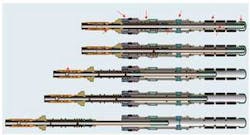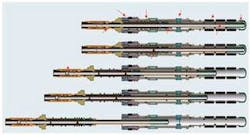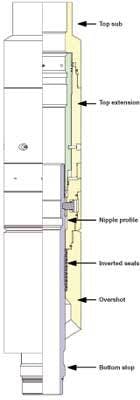Single trip completion systems reduce costs
Francisco Pineda, Alvaro Vilela - BJ Brazil
Bernard Franklin, David Walker, Blane Cole - BJ USA
An evolution of single trip systems and its successful use on the Gulf of Mexico shelf and offshore Brazil provides an opportunity to use proven technology to more efficiently complete properties in deepwater. Workstring trips on deepwater completions are the single most expensive operation. Wells are being drilled deeper, resulting in more trip time as non-productive time. Rreducing the number of trips has a significant impact on improving operational costs.
The industry’s escalating rig rates, project development costs, and fluid loss after perforating have been the key drivers in development of single trip technology. The company’s first use of the HST system in deepwater Brazil occurred early in the year 2000. In late 2004, after numerous runs in the GoM shelf, the RST system was first used successfully in the deepwater GoM from a moored or dynamically positioned drilling rig resulting in significant savings.
To clarify these trip systems:
- An HST system is a horizontal completion system designed to allow wash-down and gravel packing activities to occur with a single trip into the wellbore. The system adds the ability to perform selective stimulation in the same trip.
- The RST system facilitates perforating and sand control operations to be performed in a single trip into the wellbore utilizing workstring.
- The PST system is defined as a system in which the perforating guns, sand control placement tools, and production tubing are run together in a single trip.
- The MST system allows installation of completion hardware and sand control operations to be performed on multiple zones during a single trip into the wellbore.
HST system
The company’s main requirements for sand control equipment in horizontal gravel packed produces/injectors are:
- Maintain hydrostatic pressure on the formation during all treatment phases to prevent filter cake lift off and undesirable fluid losses which result in incomplete proppant placement.
- Improved flow areas through the sand control equipment to allow circulating at higher flow rates and lower pressures to avoid exceeding bottom hole fracture pressure, especially on long open hole intervals with low fracture gradients.
- Capability of converting the gravel packing service tool into a stimulation tool to save valuable rig time plus efficient mechanical diversion of the stimulation fluid.
- Provide isolation of the horizontal section after the stimulation process to avoid formation damage due to fluid losses by using an improved dual flapper valve design.
The company’s HST system has the capability in one trip to maintain bottom hole pressure during all completion operations including packer setting and service tool release, gravel placement, and selective clean-up of the filter cake after the completion.
The system’s integral part is the slick joint inverted seal technology along with strategically placed inverted seal subs, which are utilized to provide selective mechanical diversion of treating fluids. This component also aids in setting of the optional external-casing packers after the gravel pack treatment is performed. Additionally, the slick joint may also act as a wash pipe to take returns during the gravel pack treatment allowing effective placement of stimulation fluids to selectively break the filter cake of the open hole after the gravel pack treatment.
Additionally, the company may run differential operated circulating valves along the washpipe to minimize the friction pressures created during the gravel pack placement reducing the potentially increase gravel pack placement pressure and risk of fracing the formation during the gravel pack treatment.
For fluid loss control after filter cake removal, the company can activate the system, which includes optional flapper valve or ball type wellbore isolation valve.
During the wellbore stimulation treatment, the company runs a ball operated drill pipe acid check valve to stop the back flow of the treating fluid while making up of the work string further reducing the time required for completion operations.
RST system
The operator’s completion system incorporates perforating guns and sand control placement tools run simultaneously in a single trip. Key to the system is the unique ability to separate the perforating guns from the gravel pack assembly dowhnhole prior to gun detonation. This reduces the affect of mechanical or hydraulic shock loads occurring during gun detonation.
The company will first run an auto releasable temporary anchor or depth verification tool (DVT) into the wellbore on wireline or workstring. The next stage involves running into the well with perforating guns and the gravel packer assembly set up for overbalanced or underbalanced perforating. The company anchors the tubing conveyed perforating guns (TCP) into the DVT. The operator then pulls the sand control assembly to release and moved uphole to the specified depth. The company hydraulically fired the guns releasing the DVT and allowing the TCP/DVT assembly to fall to bottom. The sand control assembly is moved down hole and set at depth across the perforated interval. Shortly afterwards, the company sets the mechanical sump packer followed by the sand control packer. At this time, the company initiates a conventional sand control operation.
PST system
This system allows a single trip perforate pack production system to be installed using the production tubing which stays in the wellbore. The company replaced the crossover tool with a production seal assembly containing a frac port, a glass disk sub for flow diversion during the gravel pack treatment, and a shifting collet for closing the frac closing sleeve.
MST system
The need to complete two or more intervals with sand control is a time consuming and complicated completion process. This system offers an infinite number of configurations depending on the well objectives. Two of the biggest issues associated with multi-zone completions are zone spacing and risk associated with the installation.
This system provides frac packing multiple zones capability in a single trip with complete zonal isolation prior to and after the simulation treatment. Plus, the system also allows the ability to provide selective or commingled production control. The company’s conventional service tool technology is used, providing live annulus and set down weight capability in both the squeeze and circulating positions. This system also offers proven shifting tool and production sliding sleeve technology with a large internal diameter equivalent to the production string.
This system may include isolated gravel pack screens with integral production sliding sleeves and a treating sleeve for placing sand or proppant. The company will utilize a technical advanced and unique tubing testable isolation packer to isolate each zone. During assembly, the company installs a single gravel pack service tool below the lowermost screened interval and connected through a concentric inner workstring to the primary workstring above the top production packer. The operator can run the entire assembly into the wellbore in a single trip. The operator can selectively open or close the production sliding sleeves and frac pack sleeves in each zone facilitating individual zonal treatment, and isolation using the system shifting tool. Once the operator has completed all of the zones, production may be selectively initiated by opening or closing the production sliding sleeves located in each interval.
HST system
Frequently, an operator’s more complex tubing production installation is required than conventional shelf wells in deepwater subsea completions. In some cases these installations require multiple trips. In South America, the operator runs an intermediate tubing installation with an anchorable seal assembly, to be stung into the gravel pack production packer (usually installed in the casing horizontal section) with the standard completion design.
The system also included a shearable sealing type device, and a landing nipple profile. The company spaces out the sealing type device in the wellbore in a deviation of 50 deg or less. The company then runs the production tubing with the workstring to sting into the gravel pack packer, hydraulically tests the packer and intermediate tubing, confirms and records the depth of the shearable device. After the operator pulls the workstring out the wellbore, another run is made to the subsea wellhead with the workstring to pre-space out the production-tubing hanger. The company’s hydraulic sealing type device facilitates this operation in one trip. This device with the landing nipple profile, may be run with an a shearable anchor, an indexing mule shoe, intermediate tubing, production tubing with all the accessories such as chemical injection mandrels, production downhole gauges, landing nipples, safety valve, control lines, and tubing hanger in one trip.
These single trip systems have field proven capability to reduce completion cycle time by 20-60% depending on zone length and number of zones to be completed.
Acknowledgements
The authors want to thank BJ Services for giving us permission to publish this paper. We also want to thank all the operating and service company personnel who have contributed to the successful implementation of this technology in the Deepwater Gulf of Mexico and South America.
Editor’s Note: This paper is a continuation of SPE 97147, “The Viability of Single Trip Sand Control Completions in Deepwater - A Case History”.


